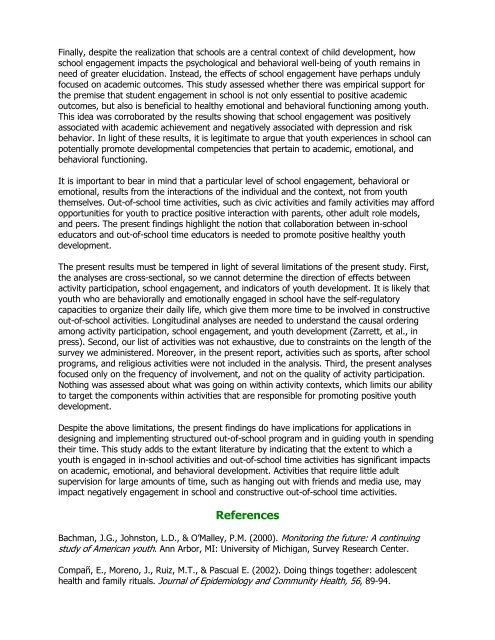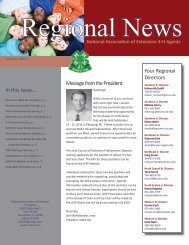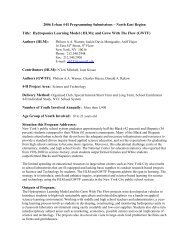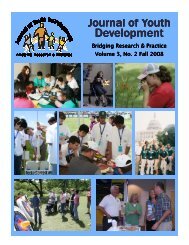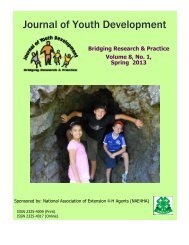Winter 2008 - Vol. 3 No. 3 - National Association of Extension 4-H ...
Winter 2008 - Vol. 3 No. 3 - National Association of Extension 4-H ...
Winter 2008 - Vol. 3 No. 3 - National Association of Extension 4-H ...
- No tags were found...
Create successful ePaper yourself
Turn your PDF publications into a flip-book with our unique Google optimized e-Paper software.
Finally, despite the realization that schools are a central context <strong>of</strong> child development, howschool engagement impacts the psychological and behavioral well-being <strong>of</strong> youth remains inneed <strong>of</strong> greater elucidation. Instead, the effects <strong>of</strong> school engagement have perhaps undulyfocused on academic outcomes. This study assessed whether there was empirical support forthe premise that student engagement in school is not only essential to positive academicoutcomes, but also is beneficial to healthy emotional and behavioral functioning among youth.This idea was corroborated by the results showing that school engagement was positivelyassociated with academic achievement and negatively associated with depression and riskbehavior. In light <strong>of</strong> these results, it is legitimate to argue that youth experiences in school canpotentially promote developmental competencies that pertain to academic, emotional, andbehavioral functioning.It is important to bear in mind that a particular level <strong>of</strong> school engagement, behavioral oremotional, results from the interactions <strong>of</strong> the individual and the context, not from youththemselves. Out-<strong>of</strong>-school time activities, such as civic activities and family activities may affordopportunities for youth to practice positive interaction with parents, other adult role models,and peers. The present findings highlight the notion that collaboration between in-schooleducators and out-<strong>of</strong>-school time educators is needed to promote positive healthy youthdevelopment.The present results must be tempered in light <strong>of</strong> several limitations <strong>of</strong> the present study. First,the analyses are cross-sectional, so we cannot determine the direction <strong>of</strong> effects betweenactivity participation, school engagement, and indicators <strong>of</strong> youth development. It is likely thatyouth who are behaviorally and emotionally engaged in school have the self-regulatorycapacities to organize their daily life, which give them more time to be involved in constructiveout-<strong>of</strong>-school activities. Longitudinal analyses are needed to understand the causal orderingamong activity participation, school engagement, and youth development (Zarrett, et al., inpress). Second, our list <strong>of</strong> activities was not exhaustive, due to constraints on the length <strong>of</strong> thesurvey we administered. Moreover, in the present report, activities such as sports, after schoolprograms, and religious activities were not included in the analysis. Third, the present analysesfocused only on the frequency <strong>of</strong> involvement, and not on the quality <strong>of</strong> activity participation.<strong>No</strong>thing was assessed about what was going on within activity contexts, which limits our abilityto target the components within activities that are responsible for promoting positive youthdevelopment.Despite the above limitations, the present findings do have implications for applications indesigning and implementing structured out-<strong>of</strong>-school program and in guiding youth in spendingtheir time. This study adds to the extant literature by indicating that the extent to which ayouth is engaged in in-school activities and out-<strong>of</strong>-school time activities has significant impactson academic, emotional, and behavioral development. Activities that require little adultsupervision for large amounts <strong>of</strong> time, such as hanging out with friends and media use, mayimpact negatively engagement in school and constructive out-<strong>of</strong>-school time activities.ReferencesBachman, J.G., Johnston, L.D., & O’Malley, P.M. (2000). Monitoring the future: A continuingstudy <strong>of</strong> American youth. Ann Arbor, MI: University <strong>of</strong> Michigan, Survey Research Center.Compañ, E., Moreno, J., Ruiz, M.T., & Pascual E. (2002). Doing things together: adolescenthealth and family rituals. Journal <strong>of</strong> Epidemiology and Community Health, 56, 89-94.


